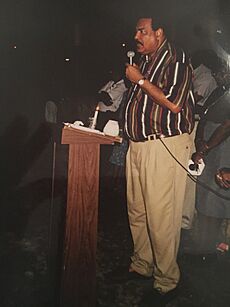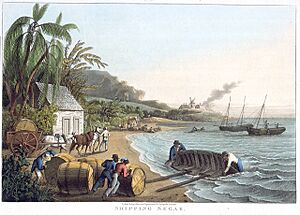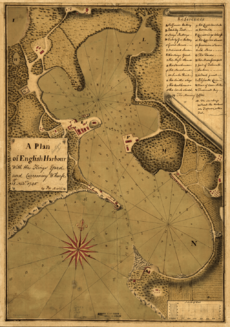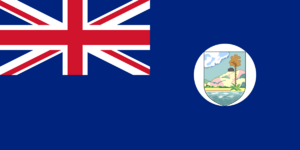History of Antigua and Barbuda facts for kids
The history of Antigua and Barbuda tells the story of these islands from when the first people arrived thousands of years ago, all the way to today. Before Europeans came, three different groups of Amerindian people lived on the lands that are now Antigua and Barbuda. England claimed the islands and started settling them in 1632. Under English and later British rule, many people from Britain and enslaved Africans came to the islands. In 1981, the islands became independent as the country of Antigua and Barbuda.
Contents
Early Island Life (2900 BC–17th century)
Antigua was first settled by early people who hunted and gathered food. These groups are sometimes called "Archaic People." The oldest settlements found on the island are from about 2900 BC.
Later, new groups of people arrived who knew how to make pottery and farm. These were the Saladoid people, who traveled north from Venezuela. Around 1200 AD, Arawakan-speaking people came, followed by the Island Caribs around 1500 AD.
The Arawaks were one of the first well-known groups in Antigua. They traveled to the island in canoes from Venezuela. The Arawaks brought farming to Antigua and Barbuda. They grew famous Antiguan "black" pineapples, corn, sweet potatoes, guava, tobacco, and cotton. Some of these foods, like corn and sweet potatoes, are still important in Antiguan cooking today. For example, a popular dish called Ducuna (DOO-koo-NAH) is a sweet dumpling made from sweet potatoes. Another main food, fungee (FOON-ji), is a cooked paste made from cornmeal.
Most of the Arawaks left Antigua around 1100 AD. Those who stayed were later raided by the Caribs. The Caribs were known for their strong weapons and excellent sailing skills.
Sadly, many native people in the Caribbean faced difficult times. Diseases brought by Europeans and Africans, along with poor nutrition and slavery, greatly reduced their numbers. Many historians believe that the stress of slavery also played a part in the deaths of native people.
The native people of the West Indies were skilled at building boats. They used these boats to sail across the Atlantic Ocean and the Caribbean Sea. Because of this, Caribs and Arawaks settled many parts of South America and the Caribbean Islands. Today, relatives of the Antiguan Arawaks and Caribs still live in countries like Brazil, Venezuela, and Colombia.
British Control (1632–1981)
Christopher Columbus saw the islands in 1493 during his second voyage. He named the larger island Santa Maria de la Antigua. However, early attempts by Europeans to settle the islands failed because the Caribs defended their homes well.
England successfully started a colony on the islands in 1632. Thomas Warner became the first governor. The settlers grew crops like tobacco, indigo, ginger, and sugarcane to sell. In 1674, Sir Christopher Codrington started the first large sugar plantation in Antigua. He also leased Barbuda to grow food for his plantations. Barbuda's only town is named after him. Within 50 years, sugar became so profitable that it was the main crop and the islands' economic backbone.
Slavery was common in Barbuda from the 1700s until 1834. The island also supplied enslaved people to other places. Britain officially ended slavery in most of its colonies in 1834. After this, the freed slaves found it hard to survive on their own. There was little farmland available, and they could not get loans to buy land. So, many continued to work on plantations for very low wages or lived in poor villages as occasional workers. Sugar cane production remained the main economy for over 100 years.
During the 1700s, Antigua became the main base for the British Royal Navy fleet in the Caribbean. English Harbour Dockyard was a safe and well-protected port. Its facilities were greatly expanded in the late 1700s. Admiral Horatio Nelson commanded the British fleet there for a long time. He was not popular with local merchants because he enforced the Navigation Act. This British rule said that only British-registered ships could trade with British colonies. This caused problems for merchants who relied on trade with the newly independent United States.
Over the years, the main crops changed. Between 1953 and 1956, cotton, sugar, meat, cereals, and local fruits and vegetables were important. Eventually, farming became less important as other countries could sell goods more cheaply. More recently, Antigua has focused on a service-based economy, with tourism as its main source of income. Like other islands that depend on tourism, this can be tricky because success relies on people wanting to travel there. It also often follows a seasonal pattern, making the country vulnerable at certain times of the year.
Steps Towards Self-Rule
In 1833, all enslaved people in Antigua were freed. However, they still depended on the white plantation owners for work. It was hard for the freed population to find economic opportunities. There was not enough farmland, no access to loans, and the economy was based on farming, not factories. Working conditions remained poor until 1939. That year, a British official suggested forming a trade union movement.
The Antigua Trades and Labour Union was formed soon after. It became an important political group for Sir Vere Cornwall Bird, who became its president in 1943. The Antigua Labour Party (ALP), started by Bird and other union members, first ran in elections in 1946. They became the main party in 1951 and won many elections for a long time. Bird and the ALP lost power in 1971 but returned to office in 1976.
People and Society
The way society was organized in Antigua and Barbuda mostly developed during the colonial period. When British colonists arrived and later brought enslaved Africans, a strict social order formed. This order was based on both race and social class.
For a long time, a small group of white plantation owners controlled the islands. They were the colonial upper class. Below them were the Afro-Caribbean people, who were the working class. In between these two groups were other groups like free people of color, along with Portuguese and Syrian immigrants. These groups often worked in jobs like law, medicine, and banking.
Between 1847 and 1852, about 2,500 Portuguese immigrants came to Antigua from the island of Madeira because of a severe food shortage. They started many small businesses and quickly joined the middle class. Syrian immigrants began arriving in the 1950s. They mostly work in import businesses and some academic jobs. As of 2008, there were about 475 to 500 permanent residents of Syrian background in Antigua and Barbuda.
The Irish first came to Antigua as either indentured servants (people who worked for a period to pay off their travel debt) or merchants. Many Irish indentured servants were sent to Antigua during the British conquest of Ireland. As more enslaved Africans were brought to Antigua, many Irish people left to find opportunities elsewhere.
Today, the Afro-Caribbean people make up about 91% of the country's population. They are mostly descendants of enslaved Africans brought from West and Central Africa. About 4.4% of the Black Antiguan and Barbudan population are of mixed race.
Independent Antigua and Barbuda (1981–Present)

The islands became independent from the United Kingdom in 1981. They became the nation of Antigua and Barbuda. However, it is still part of the Commonwealth of Nations. It is also a constitutional monarchy, meaning King Charles III is the King of Antigua and Barbuda. He is represented by the Governor-General of Antigua and Barbuda.
In 1997, Prime Minister Lester Bird announced a plan to give a group of islands off Antigua's coast to Malaysian developers. These islands were sensitive for the environment and had been considered for national park status. The plan included building a large hotel, a golf course, and a casino. This caused a lot of criticism from environmental groups and others. The project faced many lawsuits and political issues.
The Antigua and Barbuda Labour Party (ABLP) won elections again in 1984 and 1989. In 1989, the ABLP won almost all of the 17 seats. In the March 1994 elections, power passed from Vere Bird to his son, Lester Bird. The ABLP still won, taking 11 of the 17 seats. The United Progressive Party won the 2004 elections. Baldwin Spencer became Prime Minister, ending the ABLP's long time in power. Baldwin Spencer was Prime Minister from 2004 to 2014.
In 2014, the Antigua and Barbuda Labour Party won back power with their leader, Gaston Browne. Three years later, a new election was called. The ABLP, led by Prime Minister Gaston Browne, won by a huge margin in the 2018 Antiguan general election. They won 15 out of 17 seats.
General elections were held again on January 18, 2023. The ABLP kept its majority in the House of Representatives, winning 9 seats. The United Progressive Party won 6 seats. Gaston Browne was sworn in for his third term as prime minister the day after the election. After the death of Queen Elizabeth II in 2022, Prime Minister Browne announced plans for a vote on whether Antigua and Barbuda should become a republic.
See also
 In Spanish: Historia de Antigua y Barbuda para niños
In Spanish: Historia de Antigua y Barbuda para niños
- Antigua and Barbuda
- Antigua Carnival
- British colonization of the Americas
- History of the Americas
- History of the British West Indies
- History of the Caribbean
- Politics of Antigua and Barbuda
- List of prime ministers of Antigua and Barbuda




